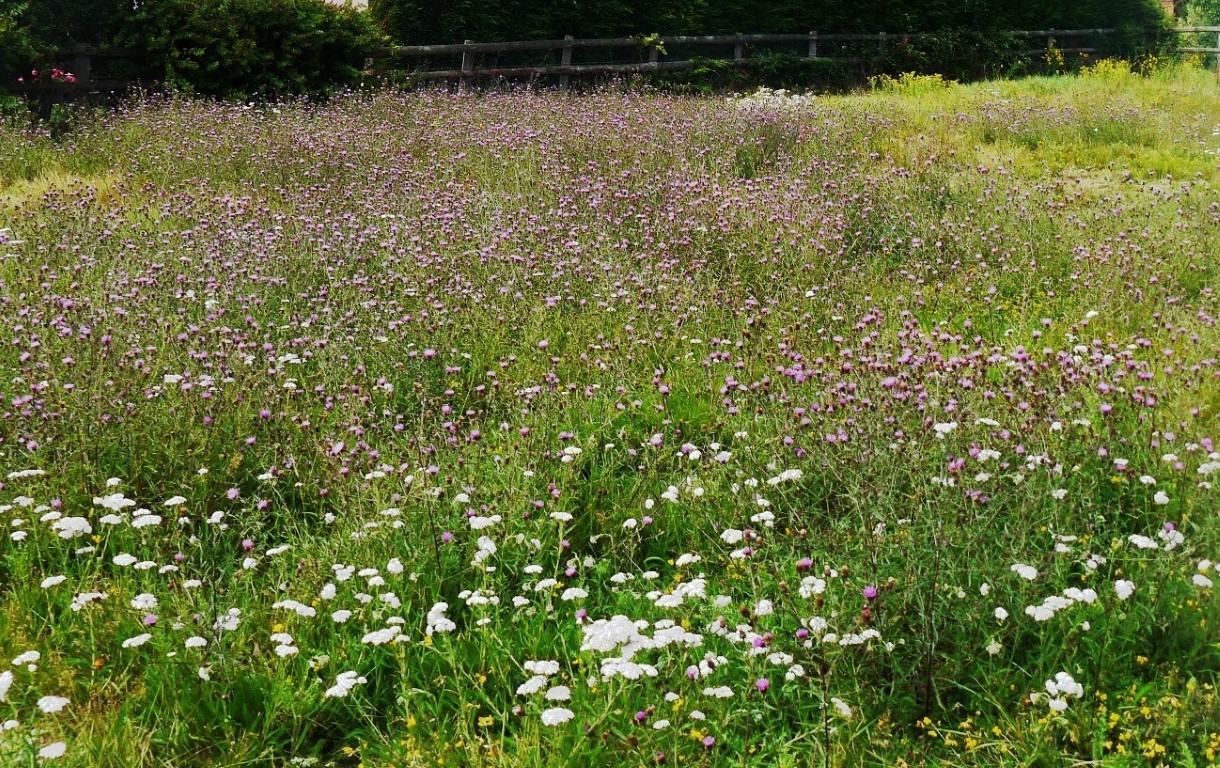
The first 18 days of July were largely dry and often very warm, the exception being the 11th going into the 12th. On the morning of the 12th, we recorded 29.5 mm of rain, the wettest 24 hours of the month. After the 18th, the weather tended to be cooler, windier, and wetter, and altogether July produced a respectable 71 mm. The hottest days were the 6th, 8th, and 9th, with 27°C, while the coldest daytime maximum was 16°C on the 24th.
https://www.kentfieldclub.org.uk/news/little-barton-farm-wildlife-notes/july-2017#sigProId4ee23a1c10
With 14 wildflowers blooming for the first time, our species tally for the year reached 62. We were greeted by the great willowherb on the 1st, quickly followed by fleabane (see photograph) on the 2nd, and marsh willowherb on the 3rd. The 4th produced three species including water plantain, a marginal plant by the woodland pond; gipsywort in the woodland ride, and tall melilot which absolutely loves the gravel in our drive. Back at the pond, woody nightshade began flowering on the 5th, followed by a gap until pale persicaria showed its distinctive white colours around our vegetable garden, and red bartsia bloomed beside the lake on the 11th. On the 14th the small number of ragwort which we allow to flower for a short time because of its attractiveness to insects began producing its distinctive yellow flowers. The last four flowers to bloom this month were stone parsley in the permanent pasture (15th), water mint around the lake (16th), rough hawkbit in the wildflower meadow (18th), and teasel in the ride (21st). Some wild fruits on the property have suffered a mixed fate this year. Those which have successfully ripened are the blackberries of our hedgerows and woods, the first of which were ready for eating by July 21st. These were followed by our first ripe elderberries on the 26th. Less successful, however, were the crab apples in the ride, which are eaten by some mysterious birds by the end of July every year before they can ripen. Suffering the same fate, this time by the grey squirrels, are the hazelnuts, which also disappear before we can pick some for ourselves.
On July 25th the clouded yellow was the only new sighting of the year for butterflies, and brought our total to 24 species. Our best butterfly day of the year so far proved to be the 16 species seen on the 9th July. New moth sightings began with the first six-spot burnet among the wild grasses on the 1st. July 4th produced 3 sightings all to light. The first was the ghost swift moth seen by torchlight while fluttering in the field; the second was the micro-moth Endrotricha flammealis on the lighted porch door; the third a dingy footman inside the lighted porch. July 5th found a riband wave moth inside the same lighted porch; the 9th produced a small magpie moth on the dining room ceiling; the 16th brought forth a magpie moth resting on our drive. Finally, on the 21st we spotted a cream wave moth on a waterside iris leaf, and on the 22nd we found a flame shoulder moth on the wall inside the lighted porch, to bring our species count to 41 for the year so far. The four species of dragonflies first seen this month bring our total to 18; the emerald damselfly, has still to be discovered. On the 4th July we spotted our first common blue damselfly, a rather late sighting, and possibly previously overlooked because of its tendency to spend most of its time out over the water. On the 10th we collected the exuvia of a southern hawker without seeing the pre-flight dragonfly, while on the 17th we saw a migrant hawker in our garden without finding the exuvia. Our last sighting was a mature ruddy darter on rushes beside the lake, but we have yet to find any exuviae for the species. So far, the late-season dragonflies have only appeared here in small numbers. Our ponds are down by up to 60cm vertically from high-water level, and this may well have some bearing on the low dragonfly numbers. In addition, our back woodland pond has about 40% of its area without water, and the lack of oxygen has left it covered in duckweed. As the distance from water to marginal plants is approximately 11 metres at its widest point on one side, and 2 metres on the other, the distance for an emerging larva to crawl to some of the waterside plants may leave it susceptible to predators like the grey heron. Blackbirds are also well known for taking emerging dragonflies.

